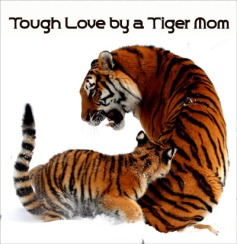For Tiger parents, the belief that academic achievement reflects successful parenting is at the center of what drives parenting behavior. Parents prioritize academic achievement for their children because they believe it is a reflection of whether they are perceived of as good parents in society. In order to accomplish this goal parents may use different dimensions of Eastern and Western parenting styles, such as monitoring their child’s activities, controlling their child’s behavior, or using forms of psychological control such as shaming to get their child to achieve the desired academic results.
Where does the tiger parenting profile fit in? We all know the classic western parenting styles: permissive, authoritative, authoritarian and neglectful. The styles range from having more warmth (permissive) to having more control (authoritarian). With the most favorable style of parenting being a balance between warmth and control (authoritative). However, tiger parenting is a unique style of parenting that includes more dimensions than parenting between warmth and control; thus, it takes into consideration the culturally rooted dimensions of parenting.
Researchers have found that while tiger parenting does exist in Asian American households, it is not the most common style of parenting and does not have the best outcomes for children. Tiger parenting is often described as merger between authoritative and authoritarian. Many Asian American parents are “authoritative and psychologically controlling” (Chan, Bowes & Wyver, 2009). Many use the concept of shaming to guide students towards acceptable behavior. However this dimension is absent from the classic Western parenting styles. Some research suggests that some degree of shaming plays a role in authoritative or supportive parenting for Asian American parents. However, in extreme cases of shaming, such as tiger parenting, it can also lead to negative outcomes for children.
Many Asian American parents pressure their children to internalize feelings of shame for not conforming to the expectations that are set by their parents. But they go about this is different ways. In some cases shaming is used to compare children to one another. Parents may use shaming to point out children who are bad examples or to point out children who are successful. Parents may also use shame to make it clear to children that their actions affect the whole family. They make it known that their actions should bing honor and respect to the family. This type and degree of shaming is closely linked to authoritative or supportive styles of parenting than permissive or easy going parenting.
However, parents may also use shaming as a form of emotional abuse. In Amy Chua’s article, her father called her “garbage” for disrespecting her mother. This form of extreme shaming is often used in the tiger parenting profile. Unfortunately, using shame in this way has led many Asian American children to experience the achievement/adjustment paradox. Researchers notes that adolescents whose parents fit the tiger parenting profile often have high levels of academic achievement but low levels of psychological adjustment. Ultimately, it is important to understand the multiple dimensions that are involved in parenting styles, to what degree they are used, and the types of effects they have on children.
Many second-generation Asian American parents are learning how to parent between Eastern and Western styles of parenting. They may have grown up in a typical Eastern family in which their fathers were the disciplinarians and used an authoritarian/tiger parenting style of parenting. However, in the West, it is emphasized that we use a more authoritative approach that allows for us to reason and negotiate with our children. Today, I have a better understanding of when and how I should use shaming and whether or not is necessary for me to use it to achieve desired socialization goals with my children. Does it help for me to point out good behavior in other children? Or does it contribute to my child having low levels of self-esteem? These are the types of questions Asian American parents should ask when they find themselves in-between Eastern and Western styles of parenting.


Pingback: Exploring the Differences between Chinese and Indian Parenting Beliefs, Practices & Styles | Amita Roy Shah's Blog
Pingback: Amita Roy Shah's Blog: Exploring the Differences between Chinese and Indian Parenting Beliefs, Practices & Styles